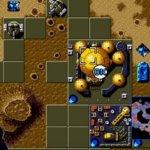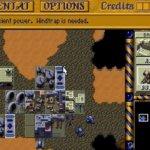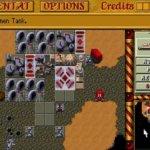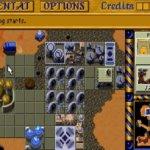Dune II

Game Description
Dune II: The Building of a Dynasty (titled Dune II: Battle for Arrakis in Europe and Dune: The Battle for Arrakis for the North American Mega Drive/Genesis port, respectively) is a 1992 real-time strategy Dune video game released by Virgin Games. It is based on David Lynch’s 1984 film Dune, which was based on Frank Herbert’s science fiction novel of the same name.
While Dune II was not the first real-time strategy (RTS) video game, it did establish a format that would be followed for years to come. As such, The Dune II video game is the poster child for “real-time strategy” games. It was a huge success, striking a balance between complexity and innovation, and laid the groundwork for Age of Empires, Command & Conquer, Warcraft, and many other RTS games that followed.
| Publishers | Virgin Games |
| Developers | Westwood Studios |
| Release date | 1992 |
| Genre | Strategy |
[title] Gameplay
The player assumes control of one of the three interplanetary houses, the Atreides, the Harkonnen, or the Ordos, with the goal of wresting control of Arrakis from the other two houses. House Ordos appears only in the non-canon Dune Encyclopedia and is not mentioned in the Dune novels. The basic strategy in the Dune II video game is to use a harvester vehicle to harvest spice from the treacherous sand dunes, convert the spice into credits via a refinery, and then build military units with these credits to fend off and destroy the enemy.
The game map begins with a fog of war covering all areas that are not visible to the player’s units. The darkness is removed as the units explore the map. In contrast to later games such as Warcraft II: Tides of Darkness, the fog of war is lifted permanently with initial exploration and does not return when units leave the area.
In addition to enemy incursions, there are other threats, such as the marauding, massive sandworm, which is capable of swallowing vehicles and infantry whole but is hampered by rocky terrain. The player can only build on rocky terrain and must use concrete foundations to prevent the structures from deteriorating due to the harsh weather conditions. Structures will still deteriorate over time regardless of the presence of those concrete slabs, but they will save money on repairs in the long run. Spice fields are denoted by orange sand, with darker orange indicating a high concentration. Some spice may be hidden as bumps on the ground (a “spice bloom”) that turn into spice fields when shot at or run over by a unit (the unit is destroyed in the ensuing “spice blow”).
Before most missions, a map of the planet Arrakis is displayed, from which they can select the next territory to play in from two or three options. This primarily affects the enemy house fought in the next mission, as all missions except the first two require the enemy to be destroyed. To reach the endgame, all nine territories must be fought, regardless of house.
Some key elements that first appeared in Dune II video game and later appear in many other RTS games include:
- A world map from which the next mission is chosen
- Resource-gathering to fund unit construction
- Simple base and unit construction
- Building construction dependencies (technology tree)
- Mobile units that can be deployed as buildings
- Different sides/factions (the Houses), each with unique unit types and superweapons
- A context-sensitive mouse cursor to issue commands (introduced in the Mega Drive/Genesis version)
Completing higher-level missions grants permission to use improved technology and higher-order weaponry unique to each House, ensuring varied gameplay. House Harkonnen, for example, may be able to build their Devastator tanks with heavy armor and ordnance but not the similarly impressive Atreides Sonic Tank. The Ordos have access to the Deviator, a specialized tank that fires a nerve gas that temporarily switches the allegiance of targeted units to the Ordos. House Ordos cannot build Atreides-style trikes, so instead builds faster “Raider” trikes, while House Harkonnen builds heavier but more expensive quad bikes.
Capturing an enemy Factory and manufacturing the desired units at the captured Factory (House Atreides’ Heavy Vehicle Factory for Sonic Tank, House Ordos’ Light Vehicle Factory for Raider trikes, House Ordos’ Heavy Vehicle Factory for Deviator tanks, or House Harkonnen’s Heavy Vehicle Factory for Devastator tanks) allows a player access to other Houses’ special units. It’s worth noting that a Deviator that isn’t owned by House Ordos still transfers control of targeted units to House Ordos, not the side that owns the Deviator. Capturing a Sardaukar Heavy Vehicle Factory allows the player to build both the Sonic Tank and the Devastator, but not the Ordos Deviator, indicating that Westwood was aware of this feature.
Buildings may only be constructed in rocky zones and must be linked to another existing structure. The player must first place concrete slabs in the construction areas to protect them from constant wear. Buildings in production can be upgraded several times at a cost, allowing for the production of more advanced units or buildings.
The final prize for the commander is the construction of the House Palace, from which superweapons can be unleashed on opponents in Dune part II final chapters. The House Harkonnen superweapon is the Death Hand, a long-range powerful but inaccurate finger of missiles, whereas House Atreides may summon local Fremen infantry warriors, over whom the player has no control, to engage enemy targets. House Ordos may unleash a fast-moving Saboteur whose primary goal is to destroy buildings.
Dune II’s AI was one of the first to be used in RTS games, and while it is superior to Herzog Zwei’s, it has a number of flaws. Examples include attacking only the side of the player’s base facing its own, a general inability to perform flanking maneuvers, and a failure to rebuild defenses. Recent fan research into the game’s engine revealed that the AI is capable of more advanced strategy, but that a large portion of these capabilities is unused due to repeatedly repeated errors in all of the game’s mission scripts.
Download [title]
We might have Dune part II download available for more than one platform. Dune II is currently available on these platforms:
DOS (1992)
Text instructions (how to play on Windows)
- Click on the download button below. It should redirect you to your download (a .rar file). Make sure you download the file properly and that your internet does not disconnect while downloading.
- Extract the “Dune_II_DOS” folder to your desktop. You will need software such as WinRAR to do this.
- Download DOSBox and put a shortcut for DOSBox onto your desktop.
- Open the “Dune_II_DOS” folder and then open the “Game Files” folder.
- Drag the file called “DUNE2” on top of the DOSBox icon and Dune II should now launch in DOSBox.
- Enjoy Dune II!
[title] Screenshots
DOS




[title] old abandonware game for 32-bit and 64-bit, Windows 7, Windows 8.1, Windows 10, Windows XP, & Windows Vista OS, and console. Safely Download free full old version [title] from oldgames-download. The game setup is tested by our gamers team and 100% working with Windows OS, Console & Desktop PCs. We have enabled direct download from our website. You will find these games files are highly compressed safe, secure, and free of any virus, spyware, or adware.